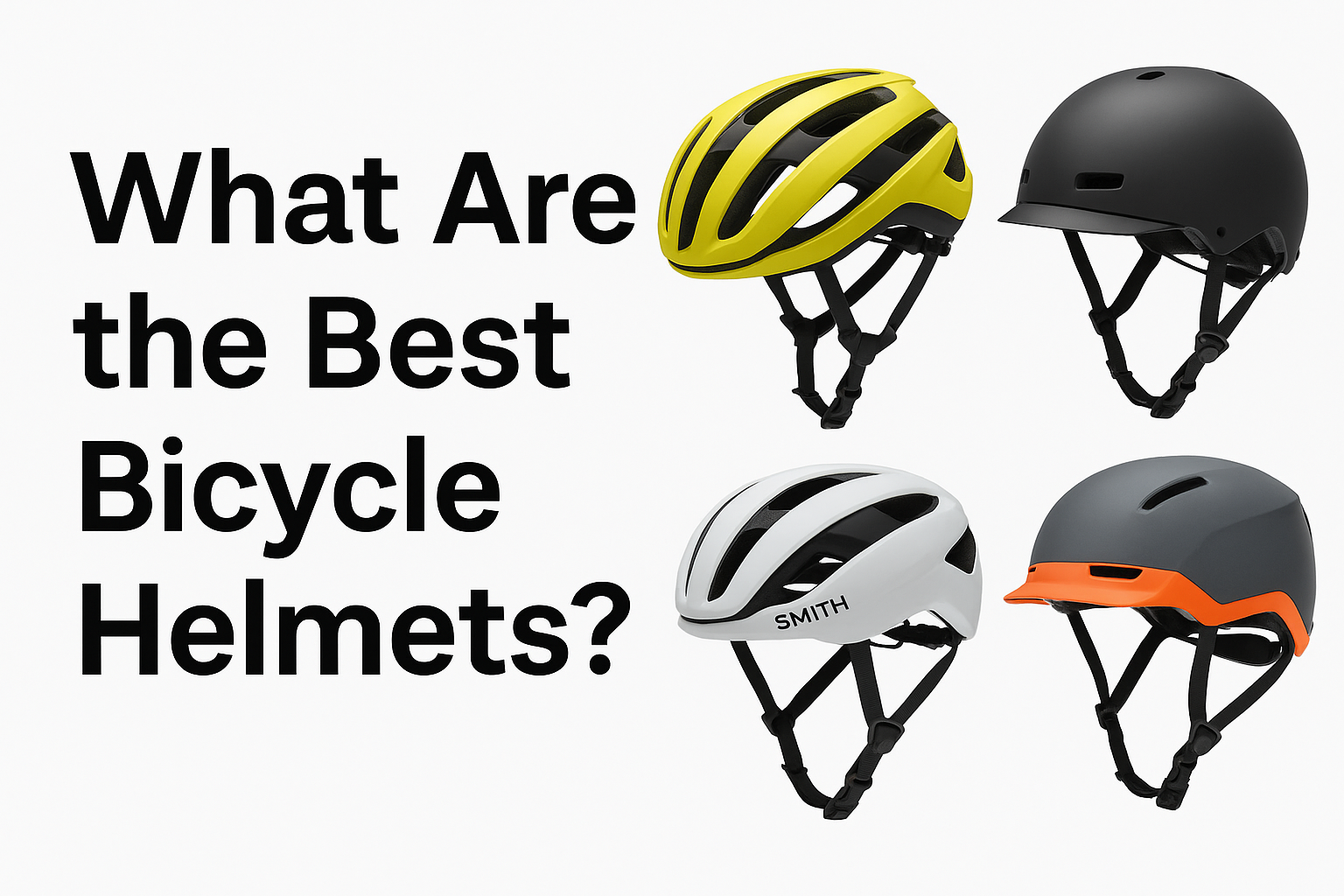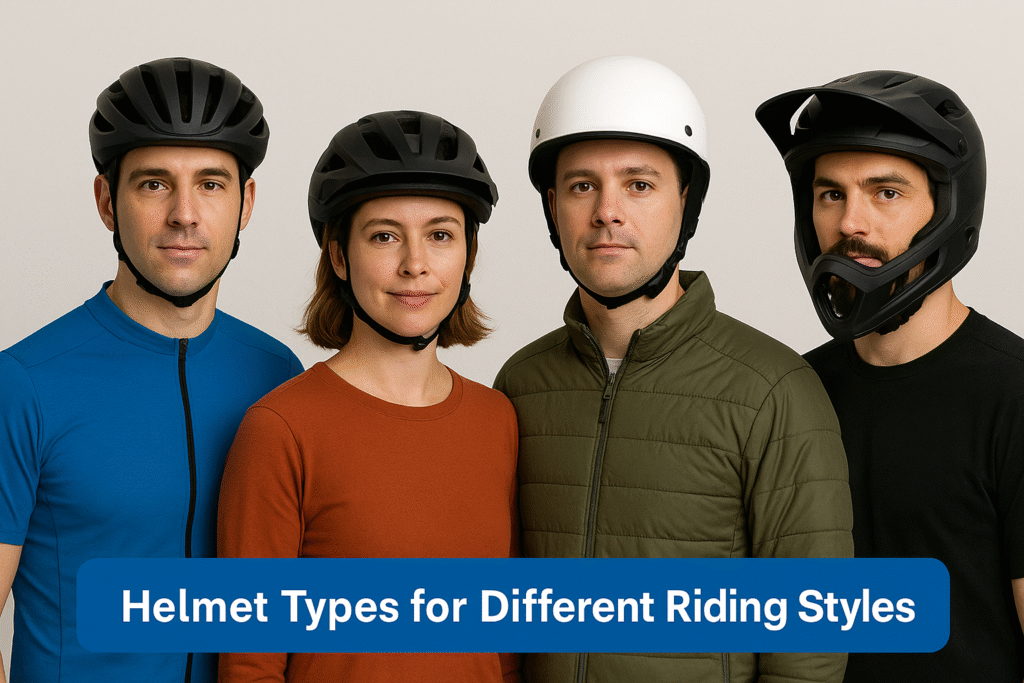Introduction
When it comes to rider safety, many cyclists ask the same essential question: what are the best bicycle helmets for protection, comfort, and style? Whether you’re looking for the safest commuter bike helmet for your daily city rides or browsing cool bike helmets for adults that blend performance with personality, the right choice can make all the difference.
With so many styles, features, and technologies available, choosing the best fit can feel overwhelming—especially for those with unique sizing needs, like finding the best bicycle helmet for small heads. In this guide, we’ll break down top-rated options for 2025, explain key features to consider, and help you find a helmet that fits your ride, your head, and your lifestyle.
Table of Contents

2. Why Choosing the Right Bicycle Helmet Matters
- A properly chosen bicycle helmet significantly reduces the risk of head injuries in case of an accident or fall.
- The best bicycle helmets are engineered to meet safety standards such as CPSC or MIPS, ensuring adequate protection.
- A well-fitting helmet enhances comfort during long rides, especially for those with small heads or unique sizing needs.
- Choosing the right helmet improves ventilation and airflow, helping to keep the rider cool on warm or extended rides.
- Helmets like the Giro Eclipse Spherical Bike Helmet combine advanced safety features with aerodynamic design, making them ideal for performance-focused cyclists.
- Commuters benefit from helmets with visibility features and reliable protection, making the safest commuter bike helmet a smart investment for daily riders.
- Cool bike helmets for adults not only provide safety but also match personal style, encouraging consistent helmet use.
- A helmet that fits correctly and suits your riding style ensures better focus, performance, and peace of mind on the road.
3. Key Factors to Consider When Choosing a Bicycle Helmet
- Fit and Sizing: A helmet must fit snugly without being too tight; models like the best bicycle helmet for small heads offer adjustable systems for a more personalized fit.
- Safety Certifications: Always check for helmets certified by standards like CPSC or featuring MIPS technology for enhanced protection in rotational impacts.
- Comfort and Padding: Look for breathable padding and ergonomic design, especially if you ride long distances or in hot weather.
- Ventilation: Helmets with optimized airflow, such as the Giro Eclipse Spherical Bike Helmet, help reduce heat buildup and increase comfort.
- Helmet Type: Choose a model based on your riding needs—whether you’re a commuter needing the safest commuter bike helmet or a performance cyclist.
- Weight: Lightweight helmets reduce strain on the neck and are more comfortable for extended rides.
- Adjustability: Helmets with precision adjustment dials or retention systems allow a secure and custom fit.
- Style and Design: Cool bike helmets for adults come in modern designs that blend safety with aesthetics, encouraging regular use.
- Visibility Features: Reflective elements or built-in lights improve safety for urban riders and nighttime commuters.
- Durability and Material: High-quality materials ensure long-lasting protection without compromising comfort or weight.
4. Top Picks: What Are the Best Bicycle Helmets in 2025?
A. Best Overall: Giro Eclipse Spherical Bike Helmet
- Built specifically for road cyclists who value high-speed performance, optimal ventilation, and maximum safety.
- Incorporates advanced Spherical MIPS for superior rotational impact defense.
- Exceptionally light and well-ventilated, perfect for endurance and long-distance rides.
- A standout choice among the best bicycle helmets for serious performance riders.
B. Best for Commuters: Thousand Chapter MIPS Helmet
- Built for urban riding with added visibility and a sleek, minimalist design.
- Integrated MIPS protection and magnetic tail light increase commuter safety.
- A leading choice for those searching for the safest commuter bike helmet.
C. Best for Small Heads: Smith Signal MIPS
- Features adjustable fit system and lightweight in-mold construction.
- Offers a secure fit without compromising comfort or safety.
- A reliable pick among the best bicycle helmets for small heads.
D. Coolest Looking: Nutcase Vio Adventure Helmet
- Stylish design with modern color options and bold aesthetics.
- Built-in front and rear LED lights offer increased visibility.
- Popular among riders looking for cool bike helmets for adults with solid protection.
E. Budget Pick: Schwinn Thrasher Lightweight Helmet
- Affordable yet equipped with full-shell coverage and ventilation channels.
- Equipped with a customizable fit system that adapts easily to different head shapes and sizes.
- A solid option for value-conscious riders without sacrificing safety.
5. Helmet Sizing and Fit Guide
- Measure the circumference of your head just above the eyebrows using a flexible tape measure to find your correct helmet size.
- Refer to the manufacturer’s sizing chart, as sizes may vary slightly between brands and models.
- A properly fitted helmet should sit level on your head and not tilt forward or backward during use.
- The helmet must fit securely without feeling overly tight and should sit evenly without any side gaps or pressure spots.
- Use the retention system or dial adjustment to fine-tune the fit for better comfort and stability.
- Straps should form a “V” shape just below each ear and be tight enough to hold the helmet firmly in place.
- For smaller riders, the best bicycle helmet for small heads often includes extra padding and more precise adjustability.
- A secure fit enhances both comfort and safety, which is essential when selecting what are the best bicycle helmets for your riding needs.
- Always try on different models, including cool bike helmets for adults, to ensure the right shape and feel for your head.
- Recheck the fit periodically, especially after long rides or temperature changes that may affect padding or straps.
6. Safety Standards You Should Know
- A reliable bicycle helmet must meet recognized safety standards that verify its ability to protect against impact.
- The CPSC (Consumer Product Safety Commission) certification is required for all bicycle helmets sold in the U.S.
- MIPS, or Multi-directional Impact Protection System, is an advanced safety feature designed to reduce rotational motion during angled collisions.
- The ASTM (American Society for Testing and Materials) standard is commonly used for helmets designed for youth and multi-sport activities.
- EN 1078 is the European safety standard that covers helmets for pedal cyclists, skateboarders, and roller skaters.
- Helmets like the Giro Eclipse Spherical Bike Helmet meet multiple international standards, making them ideal for high-performance use.
- Commuters looking for the safest commuter bike helmet should check for added features like reflective materials and integrated lights, along with standard certifications.
- Understanding these certifications helps determine what are the best bicycle helmets based on proven safety performance, not just design.
- Avoid helmets that do not list any compliance label, as they may not provide sufficient protection in real-world crashes.
7. Helmet Types for Different Riding Styles

Road Bike Helmets are built for aerodynamics, ventilation, and lightweight comfort—ideal for performance riders searching what are the best bicycle helmets for speed and efficiency.
Commuter Helmets prioritize all-around protection, visibility features, and a sleek look, making options like the safest commuter bike helmet perfect for daily urban travel.
Mountain Bike Helmets offer deeper rear coverage, visor protection, and impact-absorbing liners, designed for rough terrain and off-road trails.
Recreational Helmets suit casual cyclists and weekend riders, balancing comfort and basic safety at an affordable price point.
Hybrid or Multi-Sport Helmets provide flexibility for riders who switch between road, trail, and city environments, often found in cool bike helmets for adults.
Youth and Small Head Helmets are designed with compact shells and adjustable features, like those found in the best bicycle helmet for small heads.
Choosing the right type ensures your helmet aligns with your riding needs, comfort level, and safety requirements, especially when deciding what are the best bicycle helmets for you.
8. Maintenance and Helmet Lifespan
- Regularly inspect your helmet for cracks, dents, or signs of wear that could compromise its protective capabilities.
- Gently wash the helmet’s exterior and inner padding using mild soap and water; avoid using strong cleaning agents that could damage the materials.
- Keep your helmet stored in a dry, shaded area away from heat or direct sunlight, as prolonged exposure can compromise its integrity.
- Sweat and moisture buildup can affect helmet hygiene and longevity; removable pads should be cleaned and dried after frequent use.
- Always replace your helmet following a major fall or crash, even if it appears undamaged, as its protective capability may be reduced.
- Most manufacturers recommend replacing a helmet every 3 to 5 years, depending on usage and material condition.
- Helmets like the Giro Eclipse Spherical Bike Helmet often use advanced materials that extend durability, but routine maintenance is still essential.
- Commuters and daily riders using the safest commuter bike helmet may need more frequent evaluations due to consistent use.
- Ensuring your helmet remains in top condition is part of identifying what are the best bicycle helmets for long-term safety and reliability.
9. Conclusion
Finding the right bicycle helmet is essential for every rider—whether you’re commuting daily, training on the road, or riding casually. The best bicycle helmets offer a balance of comfort, fit, ventilation, and certified safety features like MIPS technology. From premium models like the Giro Eclipse Spherical Bike Helmet to value picks like the Schwinn Thrasher, the market offers options for every riding style and budget.
When determining what are the best bicycle helmets, consider factors such as head size, riding conditions, and usage frequency. Helmets designed for specific needs—like the safest commuter bike helmet or the best bicycle helmet for small heads—can significantly improve both safety and comfort.
Ultimately, choosing a helmet that fits well, meets safety standards, and suits your style encourages consistent use and long-term protection on every ride.
10. FAQs
Q1: What are the best bicycle helmets for everyday commuting?
A1: The best bicycle helmets for commuters include models with MIPS technology, rear lights, and ventilation—such as the Thousand Chapter MIPS Helmet, known for its safety and urban-friendly design.
Q2: How do I know if a bicycle helmet fits correctly?
A2: A properly fitting helmet should sit level on your head, feel snug without pressure points, and have straps forming a “V” below each ear. Many helmets, like the Smith Signal MIPS, offer adjustable fit systems for better sizing.
Q3: When should I replace my bicycle helmet?
A3: Replace your helmet every 3–5 years or immediately after a crash, even if there are no visible signs of damage. Impact can weaken the helmet’s inner structure, reducing protection.
Q4: Are MIPS helmets better than regular helmets?
A4: Yes, helmets with MIPS (Multi-directional Impact Protection System) provide added protection against rotational forces during angled impacts, making them a top choice for enhanced safety.
Q5: Which bicycle helmet is best suited for smaller head sizes?
A5: The Smith Signal MIPS is a popular option for smaller head sizes, offering lightweight comfort and precise fit adjustments, especially for riders needing a more tailored fit.
Q6: Do cool-looking helmets compromise safety?
A6: No, many cool bike helmets for adults combine stylish designs with advanced safety features. Just ensure the helmet meets certified safety standards like CPSC or EN 1078.
Q7: How do I clean my bicycle helmet properly?
A7: Clean the helmet using mild soap and water. Stay away from harsh cleaning agents or soaking the helmet, as this may harm the internal padding and foam structure.
